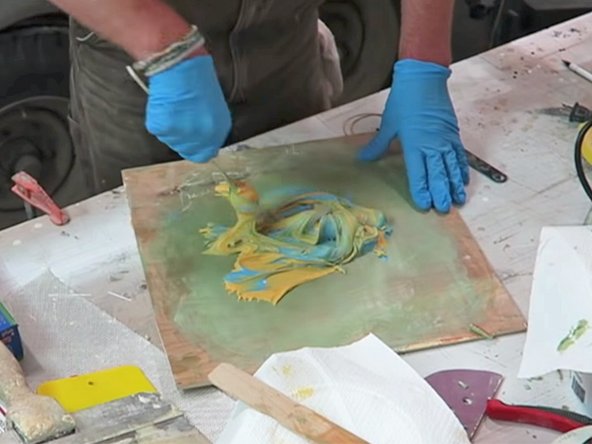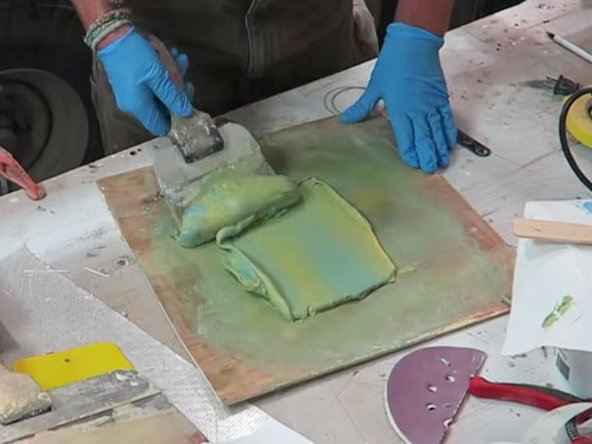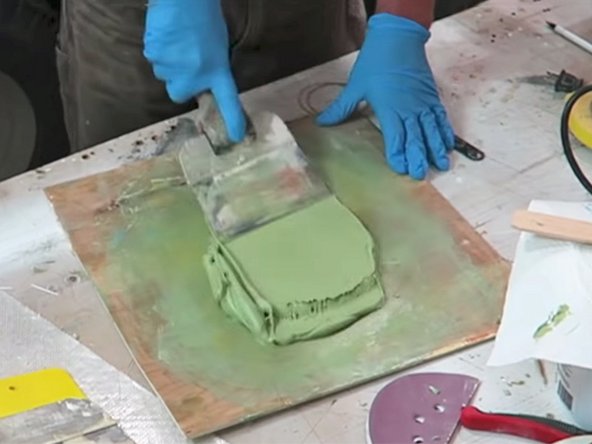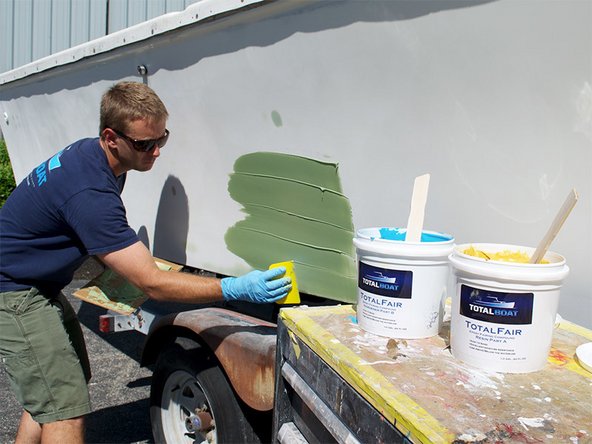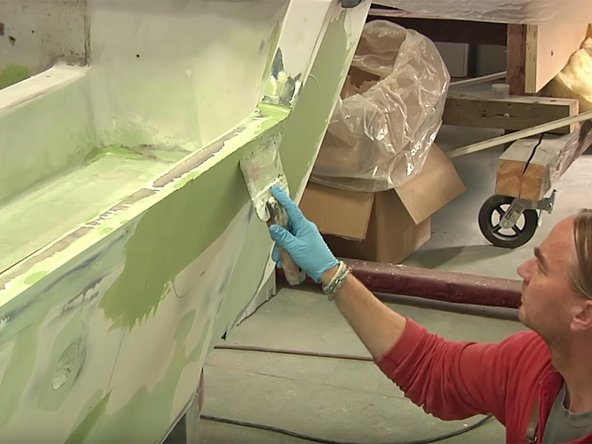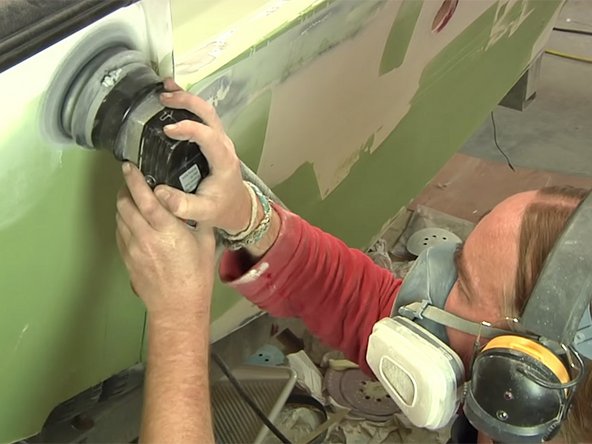Introduction
What is fairing?
Fairing means making a surface even or ‘fair’ by sanding down high spots and using a fairing compound to fill in low spots. Fairing projects include filling shallow voids, filling holes, reshaping contours, or sanding down bumps to blend in with the surrounding surface. Typically, a fairing compound is used when the holes, voids, dings, dents, or gouges are fairly shallow. For deeper or more structural voids, or holes that go all the way through the surface, consider performing a proper FRP (fiber reinforced plastic) repair with mixed resin and fiberglass cloth.
Which fairing compound should I use?
You can mix your own fairing compound using resin and fillers, or you can used a premixed fairing compound, such as TotalBoat TotalFair, which can be used above or below the waterline on properly prepared fiberglass, wood, aluminum, and steel. This lightweight, 2-component epoxy fairing compound has a simple 1:1 mix ratio, is easy to mix, spreads easily, cures fast, sands easily, and is 100% waterproof. The cured, sanded surface will be super-smooth and ready for priming, painting, or barrier coating.
IMPORTANT APPLICATION NOTES:
- TotalFair will not stick to 1-component paints or primers. If you’re applying TotalFair to an existing coating, the coating must be epoxy, polyester, or a 2-component urethane in good condition, with good adhesion.
- DO NOT apply gelcoat directly to cured TotalFair because the gelcoat will not cure properly. Before applying gelcoat, overcoat cured TotalFair with an epoxy barrier coat (such as TotalBoat TotalProtect) or an epoxy surfacing primer (such as TotalBoat 2-Part Epoxy Primer).
Tools
Video Overview
-
-
Fiberglass or Wood: (1) Wipe the surface with a clean rag dampened with acetone or denatured alcohol to remove contaminants. (2) Sand with 80-grit (or coarser) sandpaper. (3) Wipe the surface with acetone or denatured alcohol to remove residue. NOTE: For oily hardwoods, prior to using TotalFair, wipe the surface with acetone.
-
Steel: (1) Clean the surface by wiping with acetone or denatured alcohol. (2) Thoroughly grind or sandblast the steel surface. (3) Remove sanding/blasting residue by sweeping, brushing, or vacuuming. (4) Wipe the surface clean with a clean cotton rag dampened with acetone or denatured alcohol.
-
Aluminum: (1) Thoroughly sand or blast bare aluminum to bright, shiny metal. (2) Sweep, brush, or vacuum to remove residue. (3) RECOMMENDED: Apply TotalBoat Aluminum Boat Etch Wash to the bare, shiny surface, as directed. TIP: After rinsing, dry the surface completely and apply TotalFair within one hour to prevent oxidation.
-
Previously Primed/Painted Surfaces: (1) Wipe the surface with acetone or denatured alcohol. (OPTIONAL: Use TotalBoat TotalStrip paint remover to remove any coatings that are peeling.) (2) Sand with 80-grit (or coarser) sandpaper. (3) Remove residue. (4) Wipe the surface clean with acetone or denatured alcohol.
-
Sanding Tip: If you're filling a dent or gouge, sand a little beyond the edge of the void because you will be feathering the TotalFair past the edge of the void in order to ensure a thorough application the first time, and want the fairing compound to adhere properly.
-
-
-
Always start with clean tools and mixing surfaces. Combine the TotalFair yellow epoxy resin (Part A) and blue hardener (Part B) at the specified mix ratio of 1 to 1 by volume (1 part resin to 1 part hardener). There is a small tolerance if the mix is not exactly 1:1 – just do the best you can to make sure the amounts look equal.
-
Adding more hardener will not make TotalFair cure faster, and will result in an improper cure.
-
Application Tips:
-
To prevent contaminating the components, use separate sticks to dispense the resin and hardener.
-
Measure and mix only as much TotalFair as you can apply in the indicated working time, which is determined by the temperature of your working conditions.
-
The proper application temperature range for TotalFair is 50-90°F. At 90°F, working time is 15-20 minutes; at 70°F, working time is 30 minutes; and at 50°F, working time is 45-60 minutes.
-
Keep in mind that TotalFair is much easier to spread when the temperature is 60°F or warmer.
-
-
-
Use a plastic resin spreader or putty knife to mix both components thoroughly for 3-5 minutes, or until the putty is uniformly green in color.
-
Mixing Tip: While mixing, be careful not to mix too vigorously because doing so may whip excessive air into the mixture. Excessive air can cause bubbles and voids that result in an uneven surface after sanding.
-
-
-
Make sure the surface is clean and dry. Use a putty knife, trowel, or flexible epoxy spreader to apply TotalFair.
-
The maximum depth per application is ⅜”-½”.
-
When fairing a large gouge (maximum depth fill), a 6:1 width-to-depth ratio is recommended per application. If needed, you can bevel out the damaged area to make it 6:1.
-
For deep/narrow areas that exceed 6:1, apply TotalFair in stages, building up each time.
-
Filling voids up to ¾” thick may require a second application, once cured.
-
If you're repairing dings or gouges, be sure to spread the TotalFair to a thin, feather edge that goes a little beyond the border of the damaged area because it's easier to remove a little from sanding than not applying it thoroughly enough the first time.
-
-
-
If you need to apply a second layer of TotalFair in order to level the surface, wait a couple of hours for the first layer to set up, then sand and clean the surface to remove sanding residue.
-
Mix up another batch of TotalFair and apply, following the directions in Steps 3-5 (above).
-
-
-
We strongly recommended sanding TotalFair as soon as it is cured enough to sand. If cured TotalFair is allowed to sit for more than two days, it can become harder to sand.
-
Sanding time depends on the temperature conditions in your work area: At 80°F, TotalFair is ready to sand in 3 hours; at 70°F, TotalFair is ready to sand 6-8 hours; and at 50°F, TotalFair is ready to sand in 12 hours.
-
Application Tip:
-
TotalFair is a non-blushing product, but because it is still an epoxy product, there’s still the potential to encounter amine blush, which is a waxy byproduct of the epoxy curing process.
-
Just in case there's any amine blush, we recommend that you wash cured TotalFair with water and a mild soap, and let it dry completely before sanding or overcoating.
-
-
-
You can overcoat sanded TotalFair with paint, primer, epoxy primer, or barrier coat, according to the manufacturer’s directions.
-
IMPORTANT NOTE ABOUT GELCOAT: DO NOT apply gelcoat directly to TotalFair. It will not cure properly. Before applying gelcoat, overcoat TotalFair with an epoxy barrier coat (such as TotalBoat TotalProtect) or an epoxy surfacing primer (such as TotalBoat 2-Part Epoxy Primer).
-
-
-
The thickened epoxy fairing compound and solvents used in this project are hazardous to your health. It's important to wear the proper personal protective equipment (PPE), which will vary based on the job at hand and the products used.
-
Before you begin any project, we recommend the following:
-
Carefully read the safety information on all product labels.
-
Review the information in the SDS (Safety Data Sheets) for each product, including Section 8: Exposure Controls/Personal Protection.
-
Gather the proper PPE items, as stated by the manufacturers. Items can include, but are not limited to, the following:
-
Proper respirators for product application and for sanding cured material.
-
Suitable gloves to protect your hands.
-
Proper eye, face, skin, and clothing protection.
-
-
-
TotalFair did not cure properly:
-
Improper mix ratio: Sand or scrape off and redo, if necessary. The proper ratio is a 1:1 mix (by volume) of the blue and yellow components. There is a small tolerance if it's not a perfect 1:1 mix, but an uneven mixture could lead to an improper cure.
-
Not mixed thoroughly: Sand or scrape off and redo, if necessary. The components are blue and yellow to give the most apparent indication of when TotalFair is properly mixed. It should combine to form a smooth and very consistent green color.
-
Conditions too cold: If working conditions are below 50°F, wait up to a few days before trying to remove and start over. The epoxy should still cure even in conditions cooler than recommended, but it can take much longer.
-
Contamination: Sand or scrape off and redo, if necessary. Ensure that the surface is thoroughly prepared and cleaned as directed before proceeding. Take extra care to use clean and separate sticks to dispense the components, then mix the TotalFair thoroughly, and allow it to cure properly.
-
Cured TotalFair did not adhere properly:
-
Incompatible substrate: Sand or scrape off, if necessary. Make sure the substrate is compatible, and ensure that the surface is prepped properly to any possible contaminants before applying again.
-
Improper surface preparation: Sand or scrape off, if necessary. Bad surface preparation or contamination on the substrate can greatly reduce or nullify TotalFair's bond. Always be sure to thoroughly prep, clean, and dewax the surface before applying TotalFair.
-





